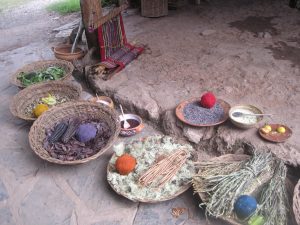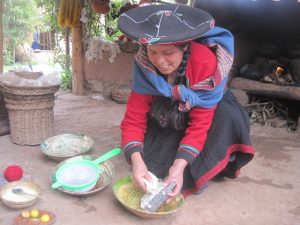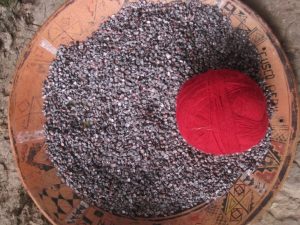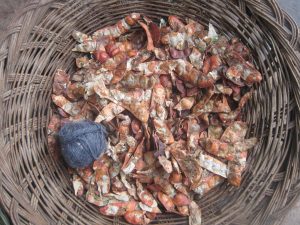
Chinchero is a very picturesque and welcoming town. Surrounded by fertile fields, it is considered the town of the rainbow. During the rainy season (from November to March) you can often see rainbows there, and sometimes up to three of them simultaneously. They appear in an amazing landscape of mountains and snow clad peaks. The people consider their mountains as their caretakers, their protective lords (Apus), along with their mother the Pachamama (the Mother Earth). Chinchero contains a great richness of culture and of customs. They are contained in its buildings, festivities, clothing, food, and more.
Chinchero belongs to the Urubamba province of the state (departamento) of Cuzco. It is found at an altitude of 3,780 meters above sea level on an Andean plateau.
When you visit the place you will be delighted with the people, the women, men, and children. They wear their traditional costumes of red and black with beautiful designs that appear to be made by the Gods, they are so finely made. Chinchero is a town which inherited the great textile tradition of the Incas.
When I visited one of the many houses of the town to see how they made their beautiful textiles I was very surprised by the difficult process the work requires. Before the people of Chinchero began to tell me about their art, they shared some muña tea with me. It is a sacred plant that has properties that are very similar to those of coca leaves. It is used to minimize altitude sickness and to make them and their guests more comfortable.
After we were served the tea they began to explain that the people of the town are very united. Thanks to this union and their work together they have been able to conserve their textile art from Inca times to now. They have kept their culture alive. Today they put together workshops in which every day they explain the process of weaving. They show the whole thing, from the washing of raw wool, to the spinning, dying and weaving.


For washing the wool they place two receptacles with hot water—it was heated over the famous hand made fogones (stoves) of mud and straw. As fuel for the flame they use sticks from trees and bushes that grow in the community. When the water is ready they show a root called saqta. It has the same name as the plant and is used as a natural detergent. They first peel it and then grate it. Hen they mix it with hot water. Like magic it raises a lot of foam and then they sieve it into another receptacle.
When the water is ready and charged with the detergent they introduce the raw alpaca or sheep’s wool. It is dirty since, as they say, this is the first time the sheep or alpacas took a bath. Then they rub the wool in their hands and when they pull it out of the water it is completely clean. If you compare it with the wool from before the change is amazing. I would not have believed it had I not seen it with my own eyes.
The women of Chinchero say that they also use this root to wash their hair. It leaves it shiny and naturally soft.
When they harvest the root they say it must be used within two or three days because if they do not do the root with go bad. If they have roots remaining when they are finished using them they must bury them to keep them fresh.

When the wool is clean they dry it and then proceed to spin it. For this they use a famous drop spindle, called a pushqa. It is a wooden instrument like a top with a long stick attached. Then attach the wool to it and drop it while giving it a twist. The pushqa pulls the wool through their fingers to thin it out. This makes it even and gives it a good twist. Whenever they are walking you will see the women spinning wool. They carry wool in one hand and the pushqa in their other. They can do it without looking.

Once the wool is spun, they dye it with colors. The dyes used are natural unlike chemical dyes that many people prefer. The natural dyes enable the weavings to maintain their color better with the passage of time. Among the ingredients for the dyes we find leaves, flowers, volcanic rocks, parasites, fruits, etc. They include the following:
Cochineal – These are parasitic insects that live on the pads of the prickly pear cactus. The color red is extracted from them, up to twenty-four tints and hues. They do this by mixing the cochineal with other ingredients such as lime, salt, volcanic stones, and by regulating the amount of time wool is boiled in the dye.
After gathering the insects they dry them in the sun. When dry they are ground very finely. A kind of red powder remains. The dye is ready.
Then they bring water to boil. They throw in a specific quantity of cochineal needed for the amount of wool they wish to dye and the intensity of red they wish to obtain. Other ingredients, as described below, are added as needed. They leave it to boil for about half an hour and then hang the wool to dry.
Chillca – The leaves from this bushy plant are used to obtain a range of greens. The process is the same as with the cochineal. To obtain the different tones of green they vary the time of boiling. For a darker tone the wool longer in the hot, colored water.
Ccollo – This flower is dried, ground, and used to obtain yellow colors. Again, the variety of tones depends on the time the wool is boiled with the flower.
Awaypili – The leaves of this plant are used to obtain purples. It is dried and the boiled with the wool.
Purple corn – The cob of purple corn is also used to obtain purples when it is boiled with the wool.
Quinsa K’ucho – These leaves, though green, produce beautiful blues.
Tara – This bush and looks very much like the tarwi plant. Its fruits are to obtain the color gray.
Once the processed wool is dry the warp is carefully laid out. Weavers use backstrap looms, which produces a cloth that has two sides and is therefore reversible. This means that from the beginning they have to carefully calculate the colors of the threads they lay out, all the while keeping the dual designs in mind. This is an amazingly complicated process but they can follow these complex patterns in their heads.
The shuttle, made of wood, moves the weft between the warp. Bone is used to tighten the threads. The women control tension by sitting back or sitting forward, since the loom is tried around their backs.
It can take them easily a month or two to make a fine and large cloth such as a carrying cloth, about a meter square.
Their designs are not found in books. People carry them in their minds. They also do not plan them out on paper. Instead, they weave. There are more than a hundred designs that people transmit from generation to generation. These designs represent their daily life, traditions, typical flowers, sacred animals, traditional tools, important personages, and more.

Here are some of the most common:
A rhombus which represents the mama qocha, the lake.
The condor, a sacred animal representing the world above or heaven.
The Andean fox, a kind of trickster.
La llama: a holy animal used as a sacrifice in tehir different ceremonies.
Two circles that represent the two ponds the town of Chinchero has, Huaypo and Piuray. This, as a result, is also a symbol of Andean duality.
The serpent is a zigzag shape that represents the worl within the earth.
The cougar which stands for this world in which we live.
The spiral stands for mother earth.
The man and the woman who wove the cloth.
When they finish the designs in the cloth they also make another piece of cloth that is a tight chord with a design of eyes. This is to provide a reminder of the eyes of the chosen princess. This cord is stitched in and becomes the border of the main cloth, ensuring it has a better finish and will not fray.





This article was really helpful. When I visited the weavers, I didn’t have time to understand these details! Thanks for sharing! I wonder what the actual plant for the soap looks like though. Have not been able to find it.